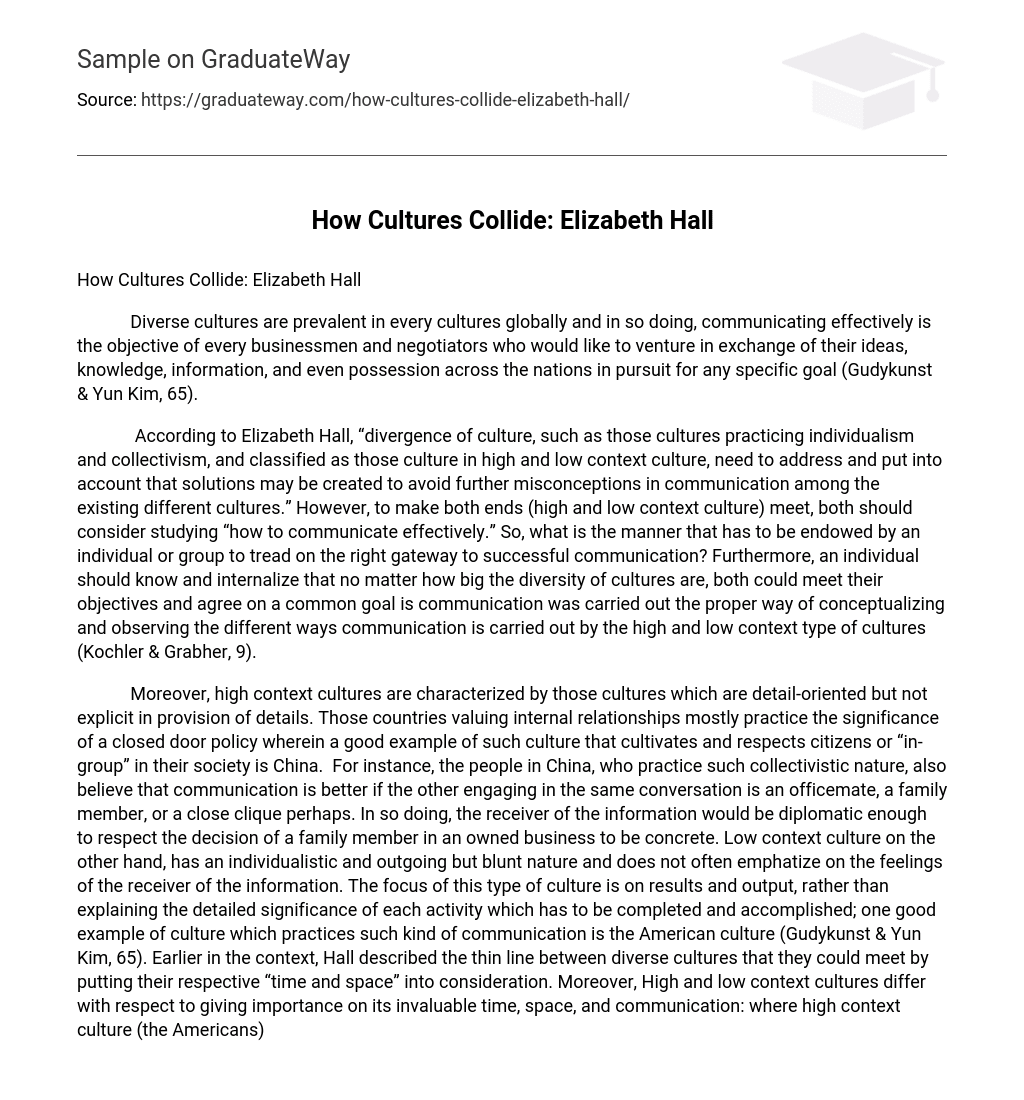Diverse cultures are prevalent in every cultures globally and in so doing, communicating effectively is the objective of every businessmen and negotiators who would like to venture in exchange of their ideas, knowledge, information, and even possession across the nations in pursuit for any specific goal (Gudykunst & Yun Kim, 65).
According to Elizabeth Hall, “divergence of culture, such as those cultures practicing individualism and collectivism, and classified as those culture in high and low context culture, need to address and put into account that solutions may be created to avoid further misconceptions in communication among the existing different cultures.” However, to make both ends (high and low context culture) meet, both should consider studying “how to communicate effectively.” So, what is the manner that has to be endowed by an individual or group to tread on the right gateway to successful communication? Furthermore, an individual should know and internalize that no matter how big the diversity of cultures are, both could meet their objectives and agree on a common goal is communication was carried out the proper way of conceptualizing and observing the different ways communication is carried out by the high and low context type of cultures (Kochler & Grabher, 9).
Moreover, high context cultures are characterized by those cultures which are detail-oriented but not explicit in provision of details. Those countries valuing internal relationships mostly practice the significance of a closed door policy wherein a good example of such culture that cultivates and respects citizens or “in-group” in their society is China. For instance, the people in China, who practice such collectivistic nature, also believe that communication is better if the other engaging in the same conversation is an officemate, a family member, or a close clique perhaps. In so doing, the receiver of the information would be diplomatic enough to respect the decision of a family member in an owned business to be concrete. Low context culture on the other hand, has an individualistic and outgoing but blunt nature and does not often emphatize on the feelings of the receiver of the information. The focus of this type of culture is on results and output, rather than explaining the detailed significance of each activity which has to be completed and accomplished; one good example of culture which practices such kind of communication is the American culture (Gudykunst & Yun Kim, 65). Earlier in the context, Hall described the thin line between diverse cultures that they could meet by putting their respective “time and space” into consideration. Moreover, High and low context cultures differ with respect to giving importance on its invaluable time, space, and communication: where high context culture (the Americans) are characterized as monochromic or formal that gives strict and rigid importance to punctuality when calling for meetings whereas on low context cultures (such as the Chinese), popular for its flexibility, they are more polychromic and somewhat informal in engaging in conversations; Similarly, space and communication vary for high and low context cultures—wherein those in high context cultures allow more non-verbal communication like eye contact or a tap on the back (spatial), while all the opposite kind of conversation without and lesser body gestures and contact takes place on a low context-culture. The ingroup of a certain culture may find a certain outgroup’s manner of communicating offensive for their part, due to diversity in norms. Hugging for example, may be interpreted as trustworthiness in Mexican culture, while interpreted as intimacy for German. So to speak, the differences often lead to barriers in communication and misinterpretations of such different manners of communicating. Therefore, flexibility and acculturization is advised for such people interested to negotiate and communicate among different nations and cultures (LeBaron).
Works Cited
Gudykunst, William B., and Young Yun Kim. (1997). “Communication with strangers.”
High context versus low context. p 65. Retrieved 04 Nov 2008
<http://www.via-web.de/273.html>
Kochler, Hans., and Gudrun Grabher. (1999). “Civilizations—conflict or Dialogue.”
Vienna: International Process Organization. P 9. Retrieved 04 Nov 2008-11-04
<http://books.google.com.ph/books?id=1Gw97VmaeyIC&pg=PA9&lpg=PA9&dq=How+cultures+collide:+Elizabeth+Hall&source=bl&ots=KiDdzyIY1H&sig=CWDmdlP8jD8eXlVX7cdvMIgRQ_Q&hl=tl&sa=X&oi=book_result&resnum=1&ct=result#PPA5,M1>
LeBaron, Michelle. July 2003. “Culture-Based Negotiation Styles.” Retrieved 04 Nov 2008
<http://www.beyondintractability.org/essay/culture_negotiation/?nid=1287>





